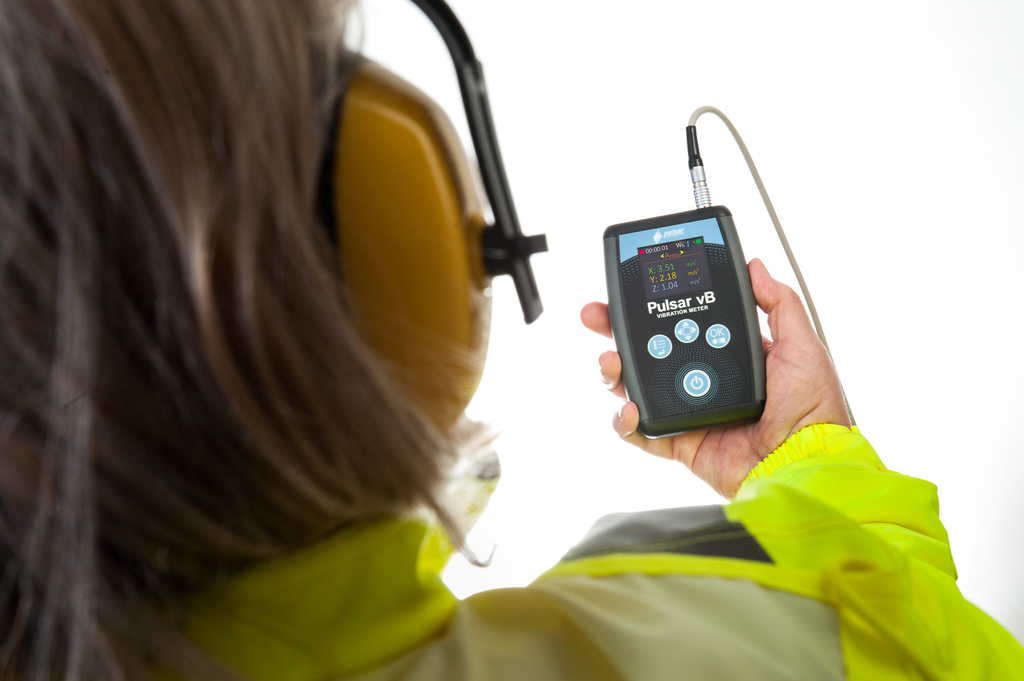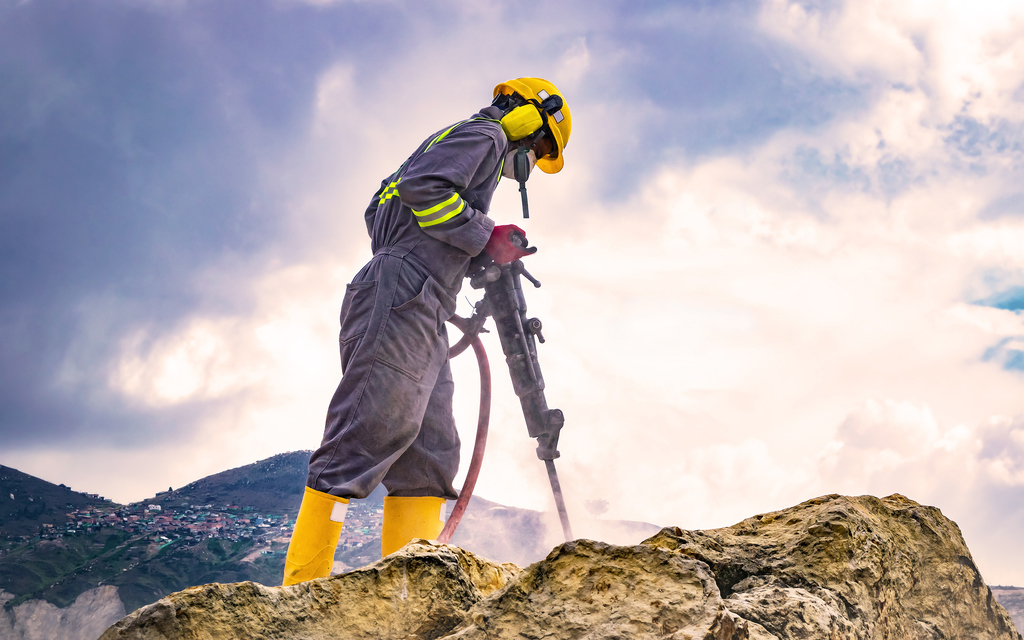
Kelly Rose
Editor

Kelly Rose
Editor
Don’t be afraid to take Hand-Arm and Whole-Body vibration measurements yourselves. Robert Dunn highlights how simple it is to get the information you need, make assessments, and take actions that stop people from being injured at work by using the tools available and the HSE’s points system.
MANY PEOPLE may find it daunting to take their own Hand-Arm and Whole-Body Vibration readings if they haven’t performed an assessment before. But don’t worry, we are going to talk you through all the tools that are available to you, to help you get the job done properly.
First, to make things a bit easier, we need to understand what HAVS is. HAVS is a life-altering condition that leaves patients with significant health consequences, known as Hand-Arm Vibration Syndrome. This is mostly caused by prolonged or frequent use of hand-held vibrating power tools.
HAVS conditions like carpal tunnel syndrome and vibration white finger (VWF), are irreversible injuries that affects blood vessels, nerves, and joints. These can dramatically affect the victim's ability to use their hands.
Under the Control of Vibration at Work Regulations 2005, employers are required to assess and identify measures to eliminate or reduce risks from exposure to harmful vibrations and provide appropriate training, and ongoing health monitoring where appropriate. Failure to do so as an employer not only puts employees at risk of serious injury, but also puts the company at risk through large fines and reputational damage. For example, the HSE has handed out over £5m in fines in just over seven years.
How to measure HAVS
The purpose of a HAVS assessment is to identify which power tools or processes cause hand-arm vibration, understand which employees are at high risk of vibration in the workplace, and what needs to be done to protect them.
A Hand Arm Vibration risk assessment needs to identify:
where vibration risks might come from (e.g. measure the vibration exposure potential of each power tool employees use using a Hand Arm Vibration meter)
who is likely to be at risk from exposure to vibration
what you need to do as an employer to comply with the law e.g. what vibration control measures are needed (to eliminate and/or reduce vibration) and how you will implement them; and,
any employees who need to be provided with ongoing health surveillance
The risk assessment needs to enable you to decide whether your employees’ exposures are likely to be above the Exposure ACTION Value (EAV) or Exposure LIMIT Value (ELV) and to identify which work activities you need to control.
The HSE sets out the following:
The daily Exposure ACTION value (EAV): 2.5 m/s2 A(8)
The daily Exposure LIMIT value (ELV): 5 m/s2 A(8)
You measure the potential a power tool has, to damage someone. The operation of a power tool is measured using a handheld vibration meter; this tells you the total vibration (Vector Sum) of the tool along three axis x, y, z (into the palm, across the knuckles, and up the arm) of the person using the tool. From here, you can use the software provided with the meter, or the HSEs calculator, to work out the potential hand-arm vibration exposure from the tool, and how long an employee can use it for before they are at risk of damage.
Using vibration points
The action value of 100 points is made up of all the trigger times from all the tools used by a worker in their job on any given working day. Assessing points per hour, or per 15 mins trigger time seems to work well for most tools. It is much simpler to add the points up and use a Ready Reckoner (based on the HSE’s) to identify overall vibration exposure than to add the vibration magnitude (A(8) Vector Sum data) of individual tools. On the Ready Reckoner, the exposures for different combinations of vibration magnitude and exposure time are given in exposure points instead of values in m/s2 A(8). Note that:
Exposure points change simply with time: twice the exposure time, twice the number of points;
Exposure points can be added together, for example where a worker is exposed to two or more different sources of vibration in a day;
The EAV (2.5 m/s2 A(8)) is equal to 100 points;
The ELV (5 m/s2 A(8)) is equal to 400 points;
|
Vibration Magnitude (over an 8-hour reference period) |
Vibration Exposure Points |
|
|---|---|---|
|
The daily Exposure Limit Value (ELV) |
5.0 m/s2 A(8) |
400 points |
|
The daily Exposure Action Value (EAV) |
2.5 m/s2 A(8) |
100 points |
Top tips to prevent HAVS
Low hand or body temperature can increase the risks of Hand Arm Vibration Syndrome (HAVS) symptoms occurring including finger blanching and damage because of reduced blood circulation. One of the key ways of preventing hand arm vibration syndrome then is to keep hands warm for workers who are exposed to vibration, and especially for those who may be more vulnerable to complications from poor circulation such as diabetics and those with existing Reynaud’s Disease.
Know your numbers – Ensure that you use your own data and don’t rely on manufacturer data. Use a hand-arm vibration meter to get accurate data.
Reduce the duration of exposure – Employees should take regular breaks from prolonged exposure and incorporate recovery periods into their workday.
Job rotation – Once an employee is nearing their EAV, try swapping them onto another task that has much lower vibration levels, ideally none.
Maintain equipment – Tools that have not been properly maintained can have much higher vibration levels. Maintaining your equipment can make sure there are no loose components within the tools and to keep the vibration levels lower.
Buy smart – When looking to purchase new equipment, be sure to check the manufacturers data for vibration. Remember, do not rely on this when doing your assessment.
Keep warm - It is a lot less work to keep fingers warm compared with getting already-cold fingers warm. So, focus on employees starting out warm and staying warm with the help of a good pair of quality gloves.
The dangers of WBV
Whole-body vibration is defined by the HSE as a shock or a jolt that is usually transmitted through the seat or feet. This can compress the spine and cause debilitating back and muscle pain to the employee.
Whole-body vibration can have a major impact on the spinal column and the surrounding muscles. When a person is exposed to WBV, their spine can be compressed, rotated and flexed, and engage their back muscles, leading to fatigue and pain.
What causes whole-body vibration?
WBV is normally caused when an employee is standing or sitting on vibrating machinery. The main cause of injury with WBV is high vibration levels along the Z axis, this is the up and down motion that can compress the employee’s spinal cord.
If your employees spend a lot of their time driving mobile machineries such as forklift trucks, excavators, tractors, or any machinery that can transmit vibration through the seat or feet, then these are at risk of being overexposed to whole-body vibration.
How to measure WBV
To measure an employee’s exposure to WBV, a seat pad accelerometer is the most efficient way to take your readings. This can either be placed underneath the employee, whether they are seated or standing.
The EAV, according to the Control of Vibration at Work Regulations 2005, is set at 0.5 m/s² A(8). The A(8) is the average over an 8-hour period.
The daily exposure action value, or the EAV, for whole-body vibration, is the level an employee is exposed to at which you need to take action. Whether this is by swapping the employee’s tasks to remove the WBV completely or by limiting exposure in other ways.
The ELV, according to the Control of Vibration at Work Regulations 2005, is set at 1.15 m/s² A(8).
The exposure limit value is the absolute maximum level of vibration that an employee can be exposed to during an average eight-hour working day. If your employees exceed this limit, they will be at a high risk of suffering injuries.
|
Vibration Magnitude (over an 8-hour reference period) |
Vibration Exposure Points |
|
|---|---|---|
|
The daily Exposure Limit Value (ELV) |
1.15 m/s2 A(8) |
400 points |
|
The daily Exposure Action Value (EAV) |
0.5 m/s2 A(8) |
100 points |
Calculation tip
The HSE has a fantastic calculator tool that will work out all your exposure times, points, and time to EAV/ELV. You can use this for both HAVS and WBV, so we highly recommend making use of this free tool.
Who can do the assessment
With both Hand-Arm and Whole-Body assessments, the measurements and reports must be done by a “competent person”. This is a bit of a grey area as there are no specific requirements that needs to be met to be classed as “competent”.
The HSE states “A competent person is someone who has sufficient training and experience or knowledge and other qualities that allow them to assist you properly. The level of competence required will depend on the complexity of the situation and the particular help you need.”
As there is no definition, it all comes down to how well you can explain your “competency” under scrutiny. Everybody has their own opinion so it is hard to say, but here are a few ways you can deem competency.
NEBOSH qualification and/or
Manufacturer training on how to use equipment and complete your assessment
IOSH accredited courses
IOA (Institute of Acoustics) courses
Robert Dunn is e-commerce marketing executive at Pulsar Instruments. For more information visit www.pulsarinstruments.com




The Evron Centre
John Street
Filey
YO14 9DW
UNITED KINGDOM
01723 339715